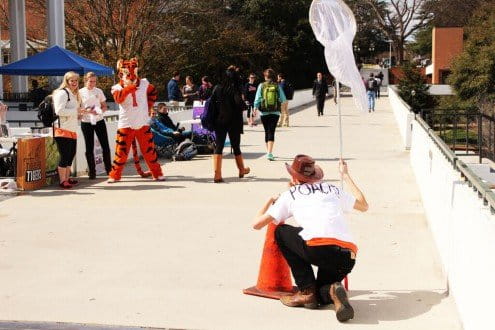- The Tigers for Tigers coalition hosts Tiger Awareness Week each November at tiger-mascot colleges throughout the United States.
- The organization uses college students’ spirit and pride in their schools’ mascots to raise awareness of the conservation issues facing wild tigers.
- Raising awareness is a critical first step to influencing policy.
This Wednesday, tigers will roam free on eight university campuses in the United States—free, that is, so long as they elude the poachers hot on their trail.
But these aren’t ordinary animals: the tigers are the schools’ sports mascots, playing public games of cat-and-mouse with students posing as poachers to raise awareness of the plight of their brethren in the wild. The stunts are a part of Tiger Awareness Week, an annual event hosted by the National Tigers for Tigers Coalition to bring tiger conservation efforts to the attention of college campuses.
The National Tigers for Tigers Coalition (NT4T), founded in 2013 from a group of existing independent tiger conservation clubs, focuses on building support and enthusiasm for environmental conservation by tapping into the school spirit and pride of students and fans to make a difference for their mascots’ wild counterparts.

Their efforts culminate each year in Tiger Awareness Week, taking place this week, November 9-13, when students at the eight participating schools host tiger-related events to help spark conversation and instill tiger pride within their communities. Among NT4T Coalition’s goals are to “strive to empower students to support meaningful tiger conservation efforts abroad, engage academic universities in tiger conservation and develop the next generation of conservation leaders.”
Students in the coalition work closely with National Wildlife Refuge Association, U.S. Fish and Wildlife Service, International Fund for Animal Welfare, and Tiger Trust India to influence policy on issues such as captive-bred big cats in the U.S. and funding for species conservation funds.
Currently, NT4T members are eagerly waiting for the Big Cats and Public Safety Protection Act bill—which aims to ban the breeding, selling, transporting and purchasing of “prohibited wildlife species…in interstate or foreign commerce” except by authorized individuals with licenses from the Animal and Plant Health Inspection Service (APHIS)—to be introduced into the Senate, so they can meet with their respective Congressmen to discuss the bill’s importance.

But the coalition has a long way to go to save this charismatic apex predator, and the organization will need the support of all 56 universities in the U.S. with tiger mascots — not to mention the schools’ 6.5 million football fans. Tigers (Panthera tigris) are one of the world’s most endangered big cats. Only about 3,200 wild tigers still roam in some Asian countries, and their numbers continue to decrease. Tigers are under threat from various human influences, including poaching and habitat loss and fragmentation.
“Students and alumni have powerful voices that can influence representatives,” said Carson Barylak, a campaigns officer at the International Fund for Animal Welfare. “Representatives ultimately want to hear from their constituents more than they want to hear from lobbyists or NGOs here in DC.”
Awareness is a key part of motivating people to engage in wildlife conservation, Barylak said. “For instance…most people don’t realize that there are 10,000 to 20,000 big cats in roadside zoos and backyards in the US. Almost across the board people are astounded to hear that. So raising awareness is the first key actor and then that awareness translates into influencing legislators. Once there is a critical mass in terms of public opinion, that’s when we really see policy change.”

NT4T isn’t the only organization using mascots to instill pride in local communities. Rare employs mascots of locally important and vulnerable species throughout the globe as part of ‘Pride Campaigns’ to promote pride and support among local communities for these species and to help inspire residents to act to protect their natural resources.
Similarly, Tiger Awareness Week puts a positive spin on issues relating to tiger conservation. “It allows students to feel like they can be a part of the solution and also teaches them that they can do something about the issues they care about,” says Sean Carnell, a founder and national coordinator of NT4T. This week, coalition groups will attract attention to tiger conservation through ‘Pie an Athlete in the Face’ events, as well as poacher-tiger chases and fundraising campaigns.
In addition to on-campus awareness events, the NT4T Coalition also works to help protect tiger habitat abroad. As part of a joint effort with the US Fish and Wildlife Service, each T4T club is raising at least US $850 to support critical habitat restoration work in the Kanha-Pench Corridor in central India. The corridor connects two parks, which together house around 120 Bengal tigers — five percent of India’s wild tiger population — in a 16,000 km2 (9,942 mi2) landscape. But the corridor is under dire threat of increased fragmentation due to human infrastructure development and agriculture.
Carnell explained that the project will be a long-term mission for T4T and “will secure existing habitat, conserve critical corridor parcels, and restore native vegetation so wildlife is free to move from one national park to the next”.

NT4T’s Carnell shared three suggestions on how to get involved in the species’ conservation:
- Educate yourself about the issues surrounding tiger conservation and become an ambassador. Use your voice and networks not only to educate others, but also empower them to take action by supporting meaningful tiger conservation efforts aboard.
- Use your voice to educate and inform congressional leaders about good conservation policy to improve the status of tigers.
- Conservation is challenging — nothing is black and white. We must remain positive, respectful and encouraging to make strategic investments to save tigers
In the end, the tiger mascots outmaneuver the students dressed as poachers- getting the chance to roar for their school sports teams another day. While things aren’t so clear-cut in Asia, the Tiger Coalition is optimistic about the potential for their student voices to change things for the better.
